
The Canon A-1: The best camera of all time.
from Shutter, by Lewis Collard

The Canon A-1: The best camera of all time.
This is the Canon A-1, a legendary and very advanced (for its time) manual focus 35mm SLR camera made from 1978 to 1985, and also the best camera ever made. Really, I don't know how these things find themselves idle, or how anyone could like them so little that they make their way onto eBay or car boot fairs. You might find me nitpicking here. You can ignore it because I could find many more things I didn't like about any other camera ever made, too; the A-1 is just superb, and the only camera I'd use these days if I weren't for the fact I find writing about other junk amusing.

Fight the powah!
Canon A-1 in program auto and Canon FD 28mm f/2.8 shooting Kodak Ektar 100.
I thought this was all metal, but after looking it up it turns out that it only looks and feels like it (which shows how good Canon were at fooling us). The chassis is aluminium, but the top and bottom plates are ABS (plastic), copper-electroplated and enameled in black. Minus a lens, it weighs in at a healthy 620 grams.
Did I mention I think it's gorgeous? Because I think it's gorgeous. Angular 1970s SLR styling is awesome (although the nooks and crannies are difficult to get clean).
Aperture-priority, shutter-priority and program automatic! Yay! As far as I know, this is the first SLR camera to have this. In fact, it's one of the first to have it, period; the much old Olympus Trip 35 did this in a somewhat less sophisticated way (but still very clever for its time). It does a pretty good job of choosing an aperture and shutter speed which will work for most photos most of the time. Sorry, there's no program shift, because this is 1978.
Yup, you can party like it's 1954 and have fully manual exposure too; turn the lens off "A" and to your preferred aperture and set the shutter speed in Tv mode, you weirdo. You'll have no indication in your viewfinder to tell you whether you're under- or over-exposed, though. Oddly, it won't even tell you what aperture your aperture ring is set to.
Nitpick: the dial (Canon called it the "AT dial") used to change shutter speeds and apertures is way too damn small for me, though people with smaller hands might not have this problem. You also can't select apertures from the aperture ring on the lens itself, only on the camera body. The beastly professional F-1 doesn't have this issue, so it's a limitation of the A-1, not of the FD system.
There's a silly multiple-exposure switch. This is the A-1's only useless feature and I'd maybe shed half a tear if they never bothered with this. (I'm not even going to count the number of useless features that my D2H has; the A-1 rocks for having so few.)
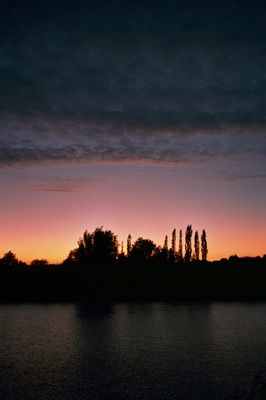
The Ouse at dusk. Canon A-1 in
program auto and Canon FD 28mm f/2.8 (wide open) shooting Kodak Ektar
100.
Electronically controlled horizontal-travel cloth shutter, fastest speed 1/1000 sec. The top speed is a little too slow if you're shooting faster films, but that's okay: if you want speed shoot digital. There's little reason to shoot fast 35mm film anymore, let alone on a bright day wide-open.
Tip: if you buy one of these, make sure the shutter is actually working. Point it to a bright light source on one of the faster speeds and make sure you actually see something when the shutter fires. As I found out, a shutter that sounds like it is working is not the same thing as a shutter actually working. Here's what happened to mine:
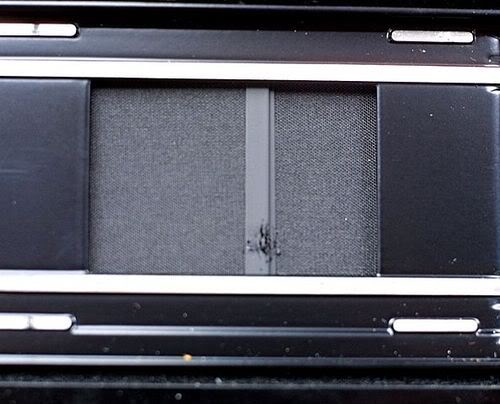
See the oily crap where the shutter curtains overlap? This was gluing them together, making them separate very very reluctantly (and not at all above 1/15 sec). This meant that at any reasonable speed, the film wasn't being exposed at all. Unfortunately, I went through two rolls of Velvia and two rolls of Superia before I found this out. Oops! The sensible thing would have been to have it repaired professionally. I'm stupid and reckless (or "brave"), so I had a glamourous assistant hold the shutter open on "B" while I caught the first curtain in its travel, swabbed the oily crap off with a petrol-soaked cotton bud, then caught the second curtain as the shutter closed and did the same thing. Don't try this at home, kids! ;)

Customs House, King's Lynn.
Canon A-1 and Canon FD 28mm f/2.8 shooting Kodak Ektar, 20 seconds
at f/9.5 (aperture priority).
The A-1 has centre-weighted through-the-lens metering, which is dead-on accurate. The "center weighted" bit simply means that it pays attention mostly to the center, and a little bit of attention to the rest, so sometimes you'll have to use exposure compensation, or lock exposure on a different part of your scene and then recompose, to get consistent lighting. No big deal, and at least the results are always predictable (unlike some of the crappier evaluative meters -- hello Pentax!).
You get exposure compensation from -2 to +2 in 1/3 stop increments/decrements. I really don't like the exposure compensation dial on the A-1; it requires pushing a button to unlock it. With the way it is positioned, it is really really awkward to do with one hand until you get used to it. A tip: do what I do and use the ISO dial instead! You can move the ISO dial easily with one fingertip. If you want to overexpose? Move the ISO to a lower value. Do the opposite for underexposure.
This has an auto-exposure lock, too, by a button on the left of the lens mount. I find this annoying; you have to hold it down to keep the lock until you take your photo, which is awkward even on normal lenses, and more or less rules out using the AE lock hand-held with a telephoto of any size (then again, are you going to do this? I don't). This is not such an issue. This is actually better than at least some later Canon cameras, which release the lock when the meter times out. The A-1's way of doing it is, at least, obvious and predictable. Later Pentax cameras are the only cameras I know of that are perfect on this count.
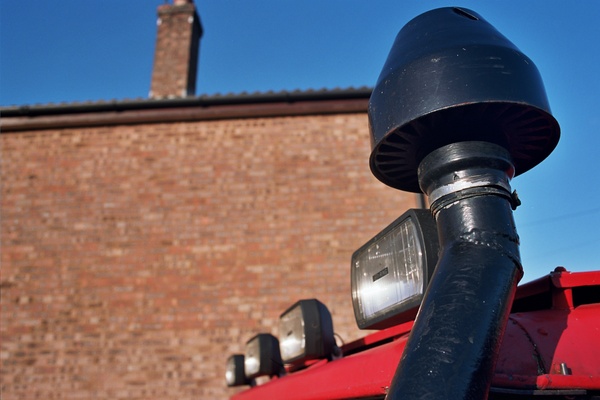
Red and blue. Canon A-1 in programmed
auto, with Canon FD 28mm f/2.8, shooting Kodak Ektar 100.
The A-1 takes one weightless A544 cell. The camera won't work at all without a battery. No big deal; these cost almost nothing to replace and can fit in your car's ashtray, so carry a spare. I'm a gigantic idiot, and I used the one which came with my camera when I bought it. Of course, my camera died on me because I'm too cheap to spend £2 on a battery (or about £10 for ten or twelve, if you know where to look). I now have three kicking around. The camera will probably die before I use these up.
There's a battery testing button on the top of the camera on the left hand side, right above the button to unlock the exposure compensation dial. Press it from time to time; if this causes the battery test LED (on the right of the camera) to blink less often than 2hz then it's time for a new one.
These are also called PX-28A, 4LR44 and a variety of other names. Same thing. Brands don't matter, but for what it's worth, I use Energizer, because they will replace any equipment that gets damaged by a battery leak.
The A-1 uses the Canon FD mount. This is obsolete; Canon completely broke backwards-compatibility when they introduced the Canon EOS autofocus system in 1987. Canon FD lenses will not work on an EOS camera. This is good news, because it means you can get some superb lenses insanely cheap, and part of what makes this the best camera, pound for pound, that you can buy today.
I believe this would have typically been sold with a 50mm f/1.8 when it was new. It's a lovely lens that feels great to use. And it seems plenty sharp, even wide open, but I've not tested this scientifically. I'm just a person on the Internet with opinions, so ignore me.
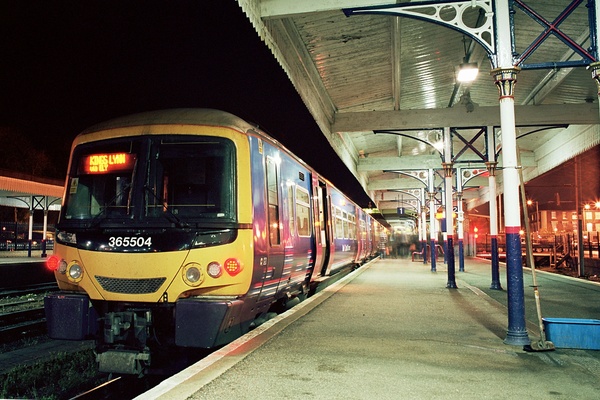
365504
at King's Lynn. Sharp enough for you? Go
full-size! This was shot with the A-1,
armed with Kodak Ektar 100, fitted with one of Canon's cheapest lenses, a
28mm f/2.8, which I bought for 30 quid in almost perfect condition.
And by the way? If you've got one and want to buy lenses for it, don't bother with anything but genuine Canon lenses. With modern Canon cameras there's almost a good reason to economise by using non-Canonical lenses, namely, that EF lenses can be horridly expensive. With the FD system? Play your cards right and you can get a superb Canon 50mm f/1.8 (if you don't have one) for the same price I paid for a strap for my D2H. Want a 28mm f/2.8? That might cost you a whole thirty pounds if you're in a rush and use "Buy It Now" on Fleabay. Every genuine Canon FD lens is pretty cheap (even the 300mm f/2.8 sells for a lot less than any other lens of its kind), and optically superb if you use them right.
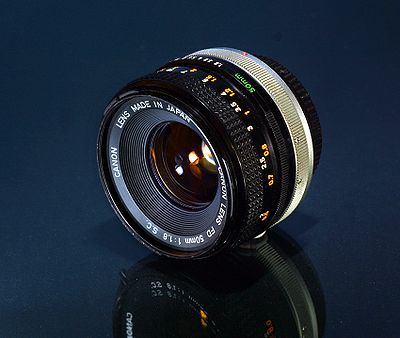
Canon FD 50mm f/1.8, with chrome locking ring: the way God intended it.
I can't for the life of me work out why people say that breech-lock FD lenses are more difficult or slow to fit than bayonet-mount systems like Nikon F and Canon EOS. I actually prefer the breech-locking system, and I dislike the later lenses without the chrome locking ring (pretending to be a bayonet-mount). I also eat kiwi fruits without peeling them, so make of that what you will.

Fun
with cheap Tudor colour negative film. Go to the
gallery entry for the story.
Canon A-1 in program auto and Canon FD 50mm f/1.8 shooting "Tudor" (pseudo-brand)
colour negative film.
It's a huge, bright SLR pentaprism. I love the simplicity of the viewfinder; you get nothing but your aperture and shutter speed displayed in your viewfinder in red LCD text (and a tiny "M" to indicate you've taken your aperture ring off "A" for a manual exposure, if you're a weirdo who does that sort of thing). It's beautiful, and totally clutter-free, and is probably my favourite thing about the camera (and also my least favourite thing of pretty much every camera made today).
The downside is that if you're doing manual exposures you have no way of knowing whether your exposure is correct or not; there's no meter to indicate this in the viewfinder. I don't do this, so that's okay, and having a meter would just clutter the viewfinder. If you're not doing manual exposures, it spanks every camera I've ever seen. You have the two critical readouts in your viewfinder. That's it. None of the junk that more recent cameras stick in there (hi Nikon!). Every camera should be like this.
The red LCD numbers vary their brightness depending on where you point them, as modern cameras do. The numbers are perfectly legible in any lighting conditions.
Cool feature: an integrated viewfinder blind. Flick a switch and a little shutter will block out the viewfinder at the eyepiece. Not that I've ever used this; but that's not the point, it's cool (and useful if you're doing long exposures (but seriously it's mostly just cool)).
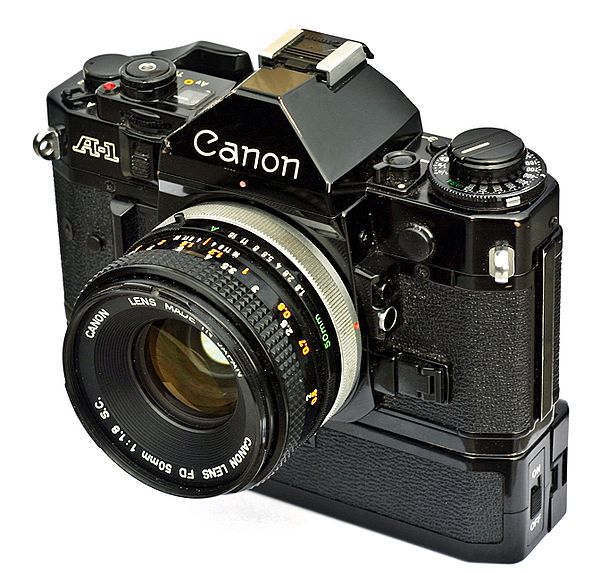
My A-1 with the Power Winder A I got with it.
Manual wind-on, by a nice, comfortable lever. Canon also made go-faster-stripes for it, if you must have powered film advance. Mine came with a Power Winder A, which gives you 2 frames per second (faster as I ever care to shoot film). I find it a bit of an albatross; it weighs about 300g. I keep it on the camera because it sounds so damn cool. Click-whirrrr-rrrr! :D
There's a couple of other winders for it, if you like. The Power Winder A2 also gives you 2 frames per second, but can switch between continuous and single-shot mode (the Winder A is always continuous). The Motor Drive MA gives you 5 frames a second, has switchable speeds and also looks seriously awesome. Get it for the awesomeness, but don't get it for practicality; the A-1 isn't really a camera for sports or things that move quickly enough to merit using a 5 FPS camera.
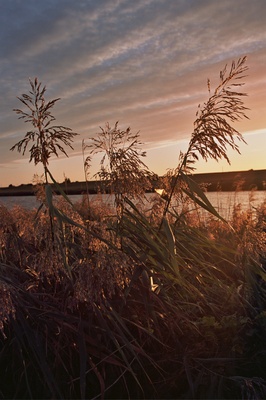
Reeds (or
go full size). Canon A-1 in program automatic,
Canon FD 28mm f/2.8, Kodak Ektar 100.
The A-1 was way ahead of its time; with the A-1, Canon even experimented with show-stopping camera bugs twenty years before digital SLRs turned this into an art form. Seriously, try this: Move the lens' aperture ring away from the A position, then move it back without taking a photograph. The viewfinder will show "EEEE EE" and refuse to take photographs from there. Oh no!
To solve this, move the multiple-exposure lever to the left, cock the shutter then move the multiple-exposure lever back to where it should be. Your A-1 will be back in action.
Fit a 50mm f/1.8, stick it in P and go outside.
Honestly, there's very little to say here. Don't let the manual focus bit scare you; the viewfinder is so big and bright that you'd have to try to get a photo out of focus. This camera is incredibly easy to use.
Ultimate beginner's camera? Definitely. It's the best camera of all time, and that doesn't stop being true because you're a beginner.

Swans. Canon A-1 in program automatic shooting
Kodak Ektar. I think I used the 50mm f/1.8.
I paid 55 quid for mine on fleaBay in early 2009, including lens, strap, almost-dead battery and power winder. This is a tiny fraction of any new digital SLR (let alone a full-frame one), and I like the A-1 better than any digital SLR. And that's still far less than the point-and-shoot digitals that tech sites gush about -- and for that money you're getting a serious, durable, semi-professional camera. And if you have a friend with one of these that has downgraded to digital, you can probably get it off them for far less. You also have the option of a vast range of awesome and incredibly cheap FD lenses. Go and buy one.
If you're a time-traveller, go back to July 1978 and pick up a copy of that month's Popular Science. Page 86 says the A-1 was selling for $595 with a 50mm f/1.8 lens. That's just a little bit under $2000 adjusted for inflation, or £1233 over here in damp, cold England.
Yup, I meant that. It is all personal preference; if there's something you like better, then we can still be friends. If you wondered, this is how I feel about everything else:
Thanks to Monica for proof-reading this before I published it.